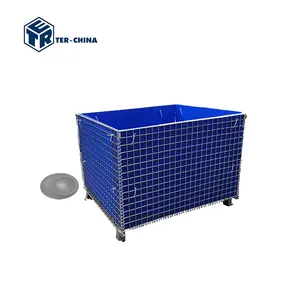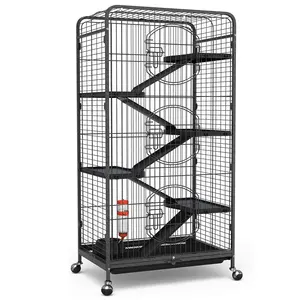
Farm Battery Cages Poultry Farming Equipment Automatic H Type Battery System Broiler Chicken Cages For Sale

1150x830xH980 J11 PET Preform Bin Pallet Cage Box Wire Metal Container Mesh Containers For Pet Preforms Storage Metal Warehouse






Ferrets are small, curious, carnivorous mammals that make wonderful pets for those who can provide them with the proper care and attention they need. One of the important aspects of ferret care is providing them with a safe and comfortable living space, which is where ferret cages come in. Ferret cages, also known as ferret toys or habitats, are enclosures specifically designed for housing and playing with ferrets.
1. Metal wire ferret cages: Metal wire ferret cages are the common type of cage for ferrets. They are typically made of stainless steel or aluminum. The wire mesh should be small enough to prevent the ferret from escaping but large enough to allow proper ventilation and visibility. Metal wire ferret cages are easy to clean, durable, and can be customized with additional shelves, ramps, and tunnels. However, they can be noisy when the ferret plays or moves around, and they may not be suitable for young ferrets who like to chew on the bars.
2. Plastic ferret cages: Plastic ferret cages are another popular option for ferret owners. They are usually made of molded plastic. Plastic ferret cages are easy to clean, lightweight, and provide a more quiet environment than metal wire ferret cages. However, they may not be as durable as metal cages, and the plastic may become brittle over time.
3. Solid-sided ferret cages: Solid-sided ferret cages are designed with solid panels instead of wire mesh. They offer a more secure environment for the ferret, as there are no gaps or openings for them to escape through. Solid-sided cages also provide better sound insulation and reduce the risk of the ferret chewing on the bars. However, they may not be as ventilated as wire mesh or plastic cages, which can lead to humidity buildup and respiratory problems.
4. Aviary ferret cages: Aviary ferret cages are large, open-topped cages that provide the ferret with plenty of space to move around and explore. They are typically made of stainless steel or aluminum and come with multiple levels, ramps, and tunnels. Aviary cages offer a natural living environment for ferrets and encourage physical activity.
1. Transportation: Large ferret cages are an essential tool for safely transporting the pet. Whether people are taking the ferret to the vet, to a friend's house, or on a road trip, a cage provides a secure and comfortable space for the furry friend. Giant ferret cages also help to prevent the ferret from getting lost or injured during transportation. 2. Playtime and exercise: Ferrets are highly active animals that require regular exercise and playtime to stay healthy and happy. Cute ferret cages can be used as a safe and enclosed space for playtime and exercise. 3. Housing multiple ferrets: If people have more than one ferret, people will need big ferret cages to accommodate them. It is important to choose a cage that is big enough to allow multiple ferrets to move around comfortably.